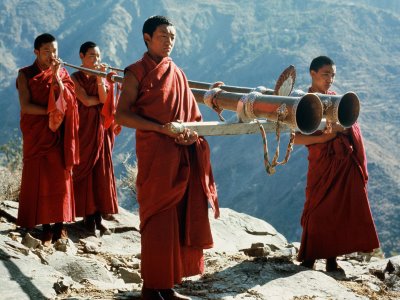






"Why Can't I Be Different and Original . . . Like Everybody Else?" - Viv Stanshall
 MACON, Ga. - Johnny Jenkins, a guitarist who worked with Otis Redding in the early 1960s and influenced Jimi Hendrix through his acrobatic playing style, has died. He was 67.
MACON, Ga. - Johnny Jenkins, a guitarist who worked with Otis Redding in the early 1960s and influenced Jimi Hendrix through his acrobatic playing style, has died. He was 67. Thanks for stopping by here again. I've been meaning to talk to you (yes, you) about the future.
Thanks for stopping by here again. I've been meaning to talk to you (yes, you) about the future.




 I spent the day flying to, and back from, Jackson, Mississippi.
I spent the day flying to, and back from, Jackson, Mississippi.
 Faith is not blind in Buddhism, but developed through one’s own experience. Emotionally, faith is experienced as doubt, just as courage is experienced emotionally as fear. When one’s doubt is greatest, one’s faith is most tested, and when one’s fear is greatest, one’s courage is most tested.
Faith is not blind in Buddhism, but developed through one’s own experience. Emotionally, faith is experienced as doubt, just as courage is experienced emotionally as fear. When one’s doubt is greatest, one’s faith is most tested, and when one’s fear is greatest, one’s courage is most tested. Without doubt, there can be no faith. Without fear, there can be no courage.
Without doubt, there can be no faith. Without fear, there can be no courage. On the web, I recently found a letter from my grandfather to Father Divine. Even more interestingly, there was also a letter back to him from the preacher.
On the web, I recently found a letter from my grandfather to Father Divine. Even more interestingly, there was also a letter back to him from the preacher. In the late 1990s, climatologist Michael Mann and colleagues Raymond Bradley and Malcolm Hughes published historical surface temperature reconstructions, concluding that the Northern Hemisphere was the warmest it has been in 2,000 years. Their research became known as the "hockey-stick" graph, because it compared the sharp curve of the hockey blade to the recent uptick in temperatures and the stick's long shaft to centuries of previous climate stability.
In the late 1990s, climatologist Michael Mann and colleagues Raymond Bradley and Malcolm Hughes published historical surface temperature reconstructions, concluding that the Northern Hemisphere was the warmest it has been in 2,000 years. Their research became known as the "hockey-stick" graph, because it compared the sharp curve of the hockey blade to the recent uptick in temperatures and the stick's long shaft to centuries of previous climate stability. Please excuse the lack of posts the past few days. I've been busy.
Please excuse the lack of posts the past few days. I've been busy. (excerpted from the NYT):
(excerpted from the NYT): George Will, of all people, pointed out the other day that on April 20 the Iraq war became as long as the Korean War. On June 15, the war was as long, 1,185 days, as U.S. involvement in World War II was when U.S. troops captured the Ludendorff railway bridge at Remagen and became the first foreign troops to cross the Rhine since Napoleon's in 1805.
George Will, of all people, pointed out the other day that on April 20 the Iraq war became as long as the Korean War. On June 15, the war was as long, 1,185 days, as U.S. involvement in World War II was when U.S. troops captured the Ludendorff railway bridge at Remagen and became the first foreign troops to cross the Rhine since Napoleon's in 1805. "When I was a boy of fourteen, my father was so ignorant I could hardly stand to have the old man around. But when I got to be twenty-one, I was astonished at how much the old man had learned in seven years." - Mark Twain.
"When I was a boy of fourteen, my father was so ignorant I could hardly stand to have the old man around. But when I got to be twenty-one, I was astonished at how much the old man had learned in seven years." - Mark Twain. "It seems that only success and money count in the world today. Those who can't follow leaders are considered losers, and thus despised. . ."
"It seems that only success and money count in the world today. Those who can't follow leaders are considered losers, and thus despised. . ." Last Saturday, we took the Zen hike along the Benton MacKaye Trail up and over Tooni Mountain and to the Taccoa River.
Last Saturday, we took the Zen hike along the Benton MacKaye Trail up and over Tooni Mountain and to the Taccoa River. Broad Peak is located at the head of the Baltoro Glacier in the Karakorum Range of Pakistan. At 26,400 feet, it is the 12th highest mountain on earth and the 4th highest in Pakistan. Once named K3 by British topographers, its local name is Faichan Kangri.
Broad Peak is located at the head of the Baltoro Glacier in the Karakorum Range of Pakistan. At 26,400 feet, it is the 12th highest mountain on earth and the 4th highest in Pakistan. Once named K3 by British topographers, its local name is Faichan Kangri. The inconvenient truth is that the very first tropical storm of the season is already picking up speed and intensity and threatening to become a hurricane. It's path looks like it will miss Atlanta (but thanks for the good wishes, Kat), although parts of Florida are already being evacuated.
The inconvenient truth is that the very first tropical storm of the season is already picking up speed and intensity and threatening to become a hurricane. It's path looks like it will miss Atlanta (but thanks for the good wishes, Kat), although parts of Florida are already being evacuated. The week's end is drawing nearer, but it felt like a month of Mondays. Once again, I was up at 5, at the zendo by 6, office by 8, home again by 6, and then at the zendo again at 7. Finally got home for keeps at 10.
The week's end is drawing nearer, but it felt like a month of Mondays. Once again, I was up at 5, at the zendo by 6, office by 8, home again by 6, and then at the zendo again at 7. Finally got home for keeps at 10. According to Grist magazine, a railroad connecting Beijing, China, to Lhasa, Tibet, has been completed, despite considerable political and environmental obstacles. The project, conceived over 40 years ago by Mao Zedong, is a symbol of Chinese domination and has faced opposition from proponents of Tibetan independence.
According to Grist magazine, a railroad connecting Beijing, China, to Lhasa, Tibet, has been completed, despite considerable political and environmental obstacles. The project, conceived over 40 years ago by Mao Zedong, is a symbol of Chinese domination and has faced opposition from proponents of Tibetan independence.